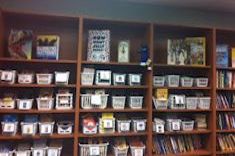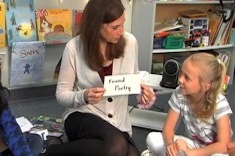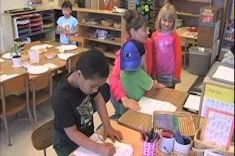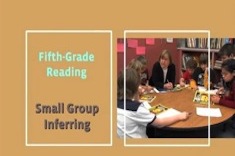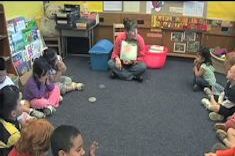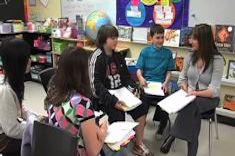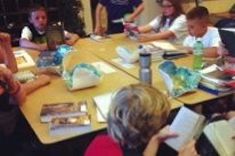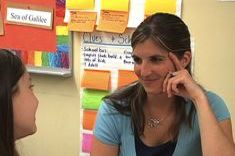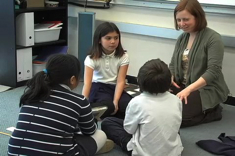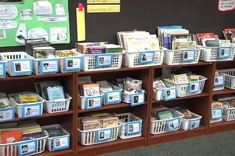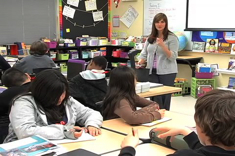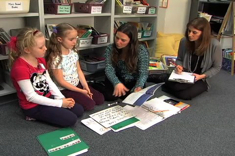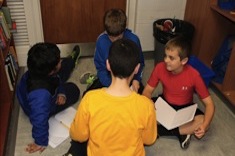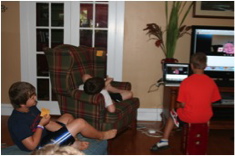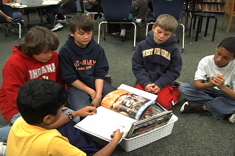Library
Choice Literacy Articles & Videos
The Choice Literacy library contains over 3,000 articles and 900 videos from 150+ contributors. Classic Classroom and Literacy Leadership subscribers have access to the entire library. Content is updated continuously, with five to six new features published each week.
Latest Content
Finding a Place for Graphic Novels in My Classroom
Katherine Sokolowski listens to her husband’s sage advice and develops a new relationship with graphic novels that disappear off her classroom shelves.
The Quest for the Perfect First Read Aloud of the Year
Franki Sibberson is on a quest to find the perfect first read aloud of the year, and the search helps her consider the goals and purpose of read alouds during the first days of school.
Focused Independent Reading in Second Grade
Sean Moore demonstrates how he helps students focus their independent reading with preparation and then with discussion after reading.
Rethinking My Nonfiction Library in Response to the Common Core
Franki Sibberson finds a new classroom, the Common Core, and tech considerations are changing the ways she organizes the nonfiction sections of her classroom library.
Lines Written at Lunchtime Above Tintern Abbey
Shirl McPhillips celebrates high summer, friendship, and handwritten notes in this poem and reflection.
Found Poetry in Second Grade
Linda Karamatic teaches a small group of her second graders about found poetry.
Making Thinking Visible
A class blog proves to be a surprisingly successful tool for building academic connections within and across classrooms of Gretchen Taylor’s middle school students.
The ABCs of Literacy Coaching (Part 1)
Heather Rader shares the essential elements of successful literacy coaching in this first installment of a month-long series.
Ask Me – I’m Not the Expert
Heather Sisson explores the complicated links between relationships and expertise for literacy coaches and teachers.
Preschool Morning Sign-In
Melissa Kolb explains the social and academic value of morning sign-in for preschoolers.
Inferring Small Group in 5th Grade
Karen Terlecky meets with a small group in her 5th grade class to discuss the strategy of inferring.
Preschool Read Aloud
Melissa Kolb talks about the power of read alouds for preschoolers and shares an example from her classroom in this video.
Guiding Groups in Middle School: Reading Poetry
Katie Doherty works with a small group of sixth graders who need extra support as they read the poem “Aspects of Autumn.”
Making the Switch from Desks to Tables
Moving from desks to tables when redesigning a classroom is about a whole lot more than just furniture. Katherine Sokolowski explains what the change has meant to her classroom.
Worldwide Cinderellas
Erin Ocon discovers that worldwide Cinderella stories are a wonderful tool for building community and cultural awareness in her seventh-grade classroom and with English language learners. Erin describes how she uses a range of Cinderella picture books with students, and provides an extensive booklist for expanding your library.
Conferring About Inferring
This reading conference from Katie Doherty’s middle school classroom builds on the whole-class lesson, and demonstrates the value of partner reading for older students.
Middle School Conferring About a Series
In this video from Katie Doherty’s sixth-grade classroom, Katie confers with a student who has returned to a series book she had previously rejected. Katie weaves in talk about strategies, particularly inferring (a focus of whole-class minilessons).
Book Club Meetings in 3rd Grade
Beth Lawson explains how she sets up book clubs in her 3rd grade classroom.
Grades 3&4 Room Tour
In this video tour, Franki Sibberson narrates a description of the grades 3&4 multiage classroom she shares with a colleague. The space is small, so Franki explains how storage areas are carefully arranged and seating is creatively designed to make the most of limited space.
Quick Take: Using Timers in Middle School Writing Workshops
In this video quick take, Katie Doherty explains why she finds a timer helpful in her middle school writing workshop.
Listen In: Strategies for Using Nonfiction Texts in Writing
The line between copying and plagiarizing can be a difficult one for young students to understand. In this video, Heather Rader and Linda Karamatic share a humane strategy for helping two second graders craft nonfiction writing.
Book Matchmaker: Read Alouds for 1st Grade
Franki Sibberson helps a 1st grade teacher select read alouds for her class in this installment of Book Matchmaker.
What is the Content for Small-Group Instruction? (Part 2 of the Grouping Series)
Heather Rader considers how assessments and observations might be used to create flexible groups.
Accuracy and Comprehension: Conferring in Second Grade
In this video from Sean Moore’s second-grade classroom, Sean confers with a student who comprehends text well but has some issues with accuracy.
Don’t Be a Sneetch
Amanda Adrian ponders end-of-year celebrations, as well as the haves and have-nots, in schools.
An At-Home Summer Reading Camp
Katherine Sokolowski comes up with a novel way to boost kids’ reading and her summer income —hosting a reading camp in her home.
Conferring with Vita: Working Through Silence
Andie Cunningham confers with Vita, an English language learner whose first language is Russian. Vita is in the silent period. Notice how Andie coaxes communication from Vita, and manages to convey a sense of delight at her work, an acknowledgment of Vita’s importance in the classroom community, and some guidance for future writing.
Listen In: About the Author
“About the Author” blurbs are a great way to bring closure to writing in workshops. In this “Listen In,” Myia begins to construct her “About the Author” page.
Matching Students to Nonfiction Texts in Grades 3-6 (BOOKLIST)
In this booklist, Mary Lee Hahn offers creative categories for considering readers in new ways.
Listen In: Writing Reviews
Heather Rader uses Kincaid’s intricate system for analyzing books to build a writing agenda in this writing conference.
Browse Content By
Type
Category
- Assessment Tools
- Big Fresh Archives
- Booklists
- Choice Numeracy
- Classroom Design
- Common Core
- Community Building
- Conferring
- Content Literacy
- Digital Literacy
- English Language Learners
- Equity
- Family Relations
- Free Samples
- Guiding Groups
- Leadership
- Literacy Coaches
- Mentor Texts
- Minilessons
- New Teacher Mentors
- Podcasts
- Poetry
- Quote Collections
- Reading Strategies
- Self Care
- Struggling and Striving Learners
- Talking and Listening
- Teacher Study Groups
- Teaching Reading
- Teaching Writing
- Word Study and Vocabulary
Author
- Melissa Quimby
- Nawal Qarooni
- Gwen Blumberg
- Julie Cox
- The Lead Learners
- Hannah Tills
- Josie Stewart
- Ruth Metcalfe
- Mallory Messenger
- Becca Burk
- Jodie Bailey
- Vivian Chen
- Mary Brower
- Tiffany Abbott Fuller
- Stephanie Affinito
- Ruth Ayres
- Leigh Anne Eck
- Heather Fisher
- Shari Frost
- Julie Johnson
- Suzy Kaback
- Gigi McAllister
- Shirl McPhillips
- Melanie Meehan
- Cathy Mere
- Debbie Miller
- Tara Barnett and Kate Mills
- Tammy Mulligan
- Dana Murphy
- Bitsy Parks
- David Pittman
- Brenda Power
- Heather Rader
- Matt Renwick
- Mandy Robek
- Christy Rush-Levine
- Gretchen Schroeder
- Jen Schwanke
- Brian Sepe
- Katherine Sokolowski
- Stella Villalba
- Jennifer Vincent
Grade Level
Choice Literacy Membership
Articles
Get full access to all Choice Literacy article content
Videos
Get full access to all Choice Literacy video content
Courses
Access Choice Literacy course curriculum and training




